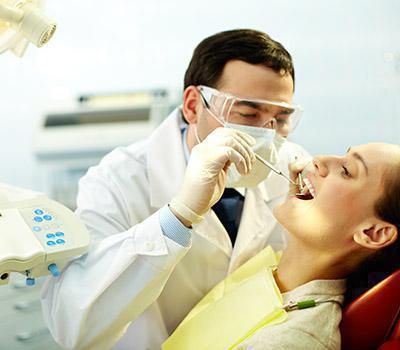Gum Surgery
Gum disease is an inflammation of the gum line that can progress to affect the bone that surrounds and supports teeth. The three stages of gum diseases are – gingivitis, periodontitis and advanced periodontitis.
Signs and symptoms of gum diseases are as follows :
- Swollen, red, tender or bleeding gums.
- Gums that recede or move away from the teeth.
- Persistent bad breath or bad taste in the mouth.
- Loose teeth.
- Pus surrounding the teeth and gums.
Some of the gum surgeries are as follows
Gingival curettage
Gingival curettage is a process of removal of inflamed soft tissue. Curettage is a closed, definitive surgical procedure performed under local anesthesia and aimed at pocket reduction and improving periodontal health.
Indications of gingival curettage are as follows :
- Edematous and inflamed tissue
- Periodontal pockets
- Increased levels of pathogenic bacteria
- Progressive bone loss
Contraindications of gingival curettage are as follows:
- Fibrotic tissue
- Medically compromised patients
Gingival curettage is done with the help of hand instruments like Gracey curette and universal curettes.
Gingivectomy
Gingivectomy is the excision of gingival by removing the diseased tissue thereby exposing the tooth surface which provides visibility and accessibility that are essential for complete removal of irritating surface deposits and thorough smoothening of the roots.
Indications of gingivectomy are as follows:
- Periodontal pocket
- Fibrous enlargement
- Crown lengthening
- Periodontal abscess
Contraindications of gingivectomy are as follows:
- Bony defects
- Fragile gingival
Gingivoplasty
Gingivoplasty is reshaping of the gingival to create physiological gingival contours. The gingival and periodontal disease often produces deformities in the gingival that are conducive for plaque accumulation and food debris, which prolongs and aggravates the disease process. Such deformities include gingival craters and clefts and crater-like interdental papillae.
Gingivoplasty is done with the help of instruments like a periodontal knife, scalpel, rotary coarse diamond stones or electrodes. The technique consists of tapering the gingival margin, creating a scalloped marginal outline, thinning the attached gingival, creating vertical grooves and shaping the interdental papilla.
Gingival flap surgery
A periodontal flap is a section of gingival and/or mucosa surgically elevated from the underlying tissues to provide visibility of and access to the bone and root surface. It also allows the gingival to be displaced to a different intraoral site. Periodontal flaps can either be full thickness flap or partial thickness (mucosal) flap.
Indications of gingival flap surgery are as follows:
- Irregular bony contours
- Deep craters
- Root resection
- Persistent inflammation
Contraindications of gingival flap surgery are as follows
- Uncontrolled angina
- Uncontrolled diabetes
- Uncontrolled hypertension
- Myocardial infarction or stroke within 6 months
- Poor plaque control
- High caries rate
Advantages of flap surgery are as follows:
- Root cleaning is done with direct vision
- Healing by primary intention
- Minimal crestal bone resorption
- Lack of postoperative discomfort
The ultimate goal of gum surgeries has been aimed to restore the health and function of periodontal tissues.
Office Hours
MON - FRI 9:00 am - 6:00 pm
SAT - SUN Closed



